Blogs
Practical Insights & Latest Happenings
Don’t miss out on the latest trends and info on SEO, search engines, social media, and more.
December 14, 2023
mothasim
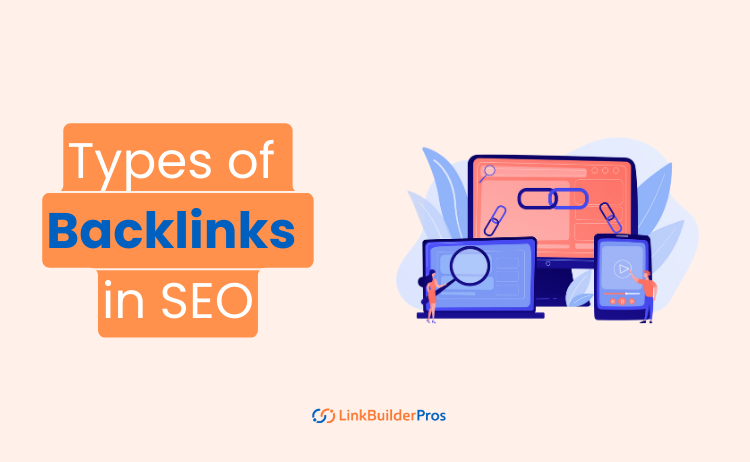
Link building is an essential part of SEO. Yes, it’s true that some websites rank well through the power of content without any significant link building activities. But that doesn’t mean it shouldn’t be incorporated into your SEO strategy because valuable inbound links from high-authority websites always help.
But before you launch your link-building campaign, you should be familiar with the different types of backlinks in SEO. After all, not all types are safe and the spammy or low-value ones can actually hurt your SEO.
Here is a complete guide on all the different types of incoming links out there for you.
Inbound links can be categorized based on their attributes, link placements, the link building process, and the acquiring process. Let’s get familiar with them:
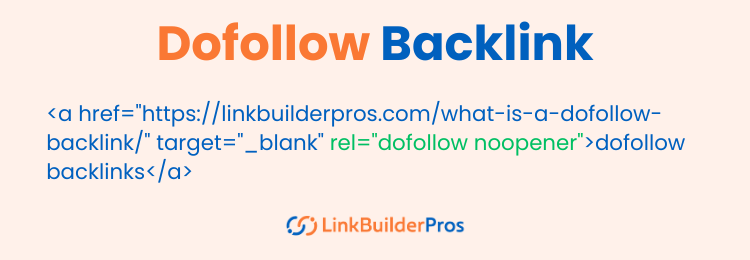
Dofollow links pass authority and SEO value from the source page to the linked page. In HTML, a regular hyperlink is by default a dofollow link unless specified otherwise.
But if all of your incoming links are do-follow then Google may think that your approach isn’t natural.
So, you should always try to diversify your profile and add other attributes mentioned below.

Nofollow links are when you deliberately assign an incoming link with an HTML tag (rel= “nofollow”) so Google doesn’t provide any authority to your linked page.
That means unlike dofollow links, nofollow links will no longer be passing any link equity to you. However, they are still important for your backlink profile.
For a healthy SEO, you need to have a stable dofollow:nofollow ratio. This is to diversify the links and let search engines see how organic your inbound links are.
Whether nofollow links really have any impact in search engine ranking or not is debatable but it surely helps gain some referral traffic and expose your brand to a wider audience.
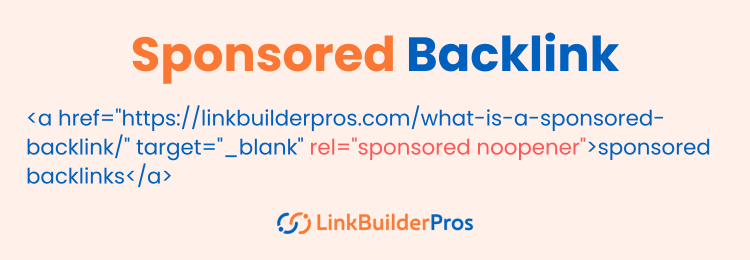
Google has a strict policy against paid link building but it allows some flexibility, such as in the case of advertising. To draw a line between the two, Google has introduced the rel= “sponsored” tag.
Like nofollow, sponsored links don’t provide any link juice either. It’s all about advertising your brand and targeting the new audience.
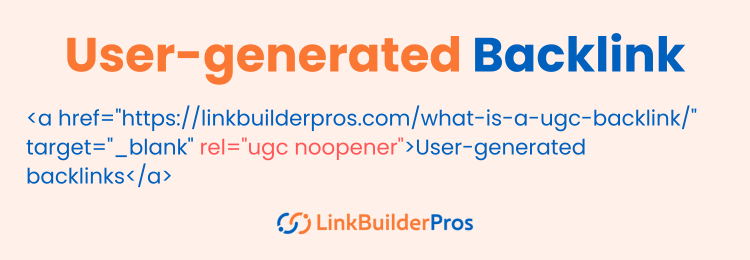
The rel=“ugc” is another attribute you can use to inform Google that these incoming links were generated by users. For example, links from forum posts and blog comments fall into this category.
User-generated links don’t carry any intrinsic value for your SEO but they help protect you from Google spam algorithms. This is because Google usually sees links in the comments as link schemes. Having this attribute reduces risks of facing any such penalty.
Editorial backlinks are one of the most high-authority links you can get.
The term “editorial” literally gives the idea of an original publication. When reputable websites or news publishers like Forbes link to a specific webpage only because of the outstanding content, that link will be considered an editorial backlink.
Imagine you have secured a backlink from Forbes! A massive link juice will flow right into your domain if you’re that lucky.
It goes without saying that gaining editorial links is hard; but not impossible. You have to focus all of your energy on developing informative, unique, and evergreen content worth linking to.
Remember, it doesn’t have to be Forbes by any means. Look out for the popular sites in your niche and find out what they’re missing. If you can present a case study or a data-heavy and research-based article that you can claim is definitely original, you’ll surely nail it over time.
Guest blogging is a popular and safe way to level up your SEO. If you get the opportunity to guest blog on a reputable site, you’ll definitely want a backlink for yourself. Even when some websites don’t allow outbound links in their content, they usually let you add one in your author profile. So, don’t miss out on this opportunity!
Reach out to your prospects with fresh ideas. Get your content tailored to the criteria of the other sites and the demand of their audience. Maintain a strict topical relevance throughout and use anchor texts accordingly.
If you own a business, you must have a digital footprint somewhere. It can be on your social media pages or more importantly, on business listing websites and local directories.
Almost all of these directories have a space where you can link your site URL for Google to index. That means you have to be well-established in local directories like Yelp, Crunchbase, FourSquare, and so on.
So, create your business profile on these listing sites and link to your website. Although this type of link is generally used to diversify your backlink profile and market your brand while the possibility of any link juice passing is next to none, we still guarantee you some referral traffic.
This one is about being an opportunist and hitting the jackpot. As a company, if you arrange some industry event or sponsor one or even donate to somebody, the rest of the businesses in your niche might give you a nod. This nod can come in forms of links or social media mentions. Links found this way are called acknowledgment backlinks.
Use SEO tools like Semrush, Ahrefs, or Moz to analyze your competitors’ backlinks and see where they got them from. Once you’re sure about the sites that offer such acknowledgments in your niche, you can engage in more such events or public speaking sessions or webinars and expect to gain some quality links as a token of gratitude.
Everybody likes a good-old badge of honor!
If you have a good standing in your niche, creating a badge is possible that acts as an award for excellence.
Award it to the reputable brands in your niche. Whenever the websites proudly show off that badge on their website, you’ll get a link back to your site.
This is a way to mutually benefit each other. The sites you’re awarding are getting recognition for their contribution to the industry and you’re gaining backlinks with new traffic in the process.
The key is to choose the worthiest website to give your badge to.
Got a huge announcement to make? Consider a press release for your announcement and put the word out there along with a link back to your site. If some red-hot news publication thinks it’s newsworthy and picks it up, be ready for a huge influx of new, interested visitors.
Although press release backlinks are no-followed, they can still help drive traffic to your site.
What you shouldn’t do is overuse these types of backlinks in SEO. What we mean is that Google considers building backlinks in bulk a part of the link scheme. Many deliver press releases solely for their link-building campaigns, which is in other words a sort of spam.
SEO should be a long-term strategy and one of the best approaches is building organic relationships with related businesses in and out of the industry.
Giving away free tools is a smart way to say “We should have each other’s back.” In exchange for using your tool for free, they’ll link back to your site since it’s a fine service you’re providing.
Research your niche and find a relevant tool to give away. It may seem like charity at first but it’s not if you think about all the backlinks you’ll be gaining this way.
You can create a simple cost calculator or a free version of one of the most popular premium tools that businesses use in your niche. You can also add a “Call to Action” (CTA) button to welcome people to sign up for the full version.
Old is gold. Take advantage of the outdated articles available online and gain some valuable inbound links without breaking the bank.
The method is simple. All you need is some contextual links from your site to place in relevant blog posts of your niche. The blogs are already there. You’re just updating them with newer information and bringing them back to life.
Your content has to be extremely informative and trendy. The data and infographics should be up to date without any question. Only then you can pitch your content to a related site or niche covering the same topic.
The link and the corresponding anchor text have to be topically relevant and flow naturally within the blog.
This is almost like guest posting but relatively cheaper and safer since the blog has an already established traffic and backlink profile. You are pretty much guaranteed a new audience this way!
Speaking of taking advantage, how about getting some deadbeats out of the way with some fresh faces on the team?
Don’t get it? Okay, we’ll stop talking sports from here on out and do what we’re both good at- discuss SEO.
There may be links on a website that don’t work anymore. They usually lead to an “Access denied” or a 404 error page. These are what we call broken or dead links.
Broken link building is when you reach out to the authority sites and offer them relevant links of your own so they can replace their dead links. This way, you can expect a decent turnout in your site traffic as that blog is sure to have regular readers.
Use the Check My Link Google chrome extension. This tool lists out all the available broken links in a site. Do it for a number of sites in your niche and see the ones you can approach with relevant links.
Reach out to them through emails and let them know how topically connected and well-researched your content is. You are likely to get a call-back sooner than later.
When it comes to the future of backlinks or link building in general, Web 2.0 backlinks are the real deal.
In simple words, Web 2.0 is where people are allowed to engage and actively contribute to the web. Take social media as an example.
If you can get backlinks from Web 2.0 platforms, it gives you an edge for sure. The Web 2.0 sites are of a much higher domain authority. So, the link you get from a Facebook or WordPress comment is more valuable than a random comment on a DA-20 blog site.
Also, there is no need for outreach here. Your links are published with a single click without any delay while high user activities help ensure that your ranking will be good enough as well.
Just sign up for Web 2.0, write some killer content, interact with the users, and link back to your site.
Read About: E-commerce Link Building Guide
Everybody wants to get their backlinks published in-text since this is the most natural way to go about it. You certainly don’t want your link to be somewhere readers won’t even look at. Besides, the surrounding text gives your link an additional context and relevance.
Just make sure you get the anchor text right. Users should be led to your link as naturally as possible.
If not spammed, comment links work great. But they shouldn’t be your primary link building strategy. For example, when a blog lacks information, you can add a useful link back to your content in the comment section to grab the audience’s attention and enjoy a valuable click-through rate.
The key is not to overdo it. That’s what spammers used to do in the past before Google made its spam update to fight it off.
So, try it if it’s relevant to the blog. Also, the comments have to be on high-authority sites; otherwise, there’s no point in commenting at all.
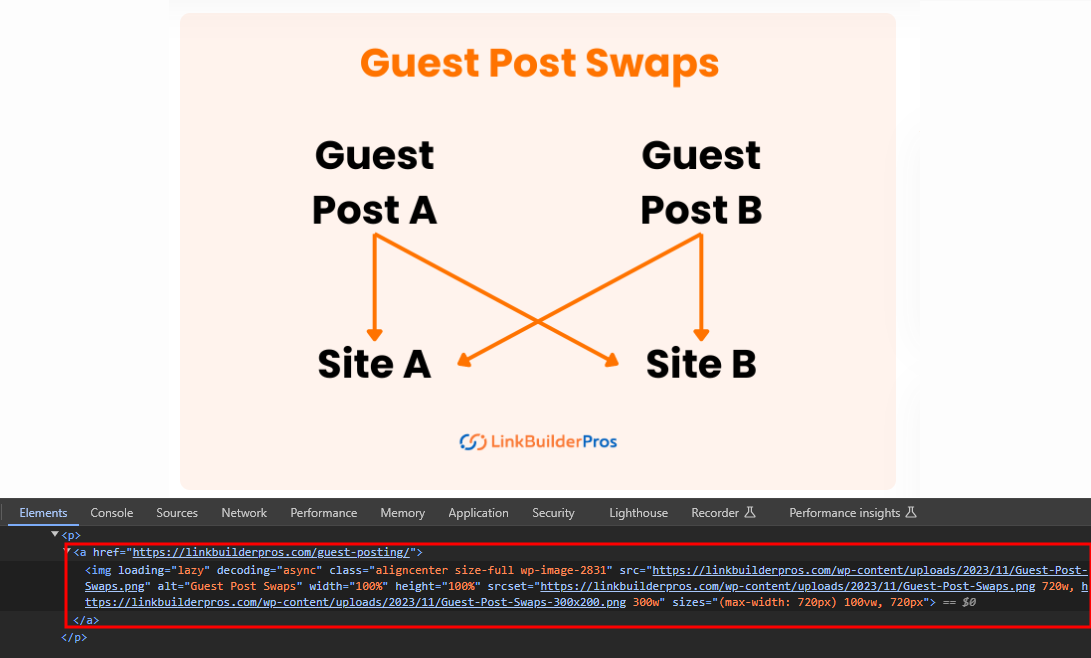
Images or infographics can also be made linkable at times. Have you ever noticed clickable banners across web pages? Those can also be considered image backlinks.
Image backlinks are actually not that effective. Google prefers in-text backlinks simply because they provide more context of their relevance with relatable anchor texts in the right places. Image backlinks just don’t cut it the same way. On top of that, sometimes they’re not even visible as they can be placed randomly, for instance, on the sidebar in the form of a banner.
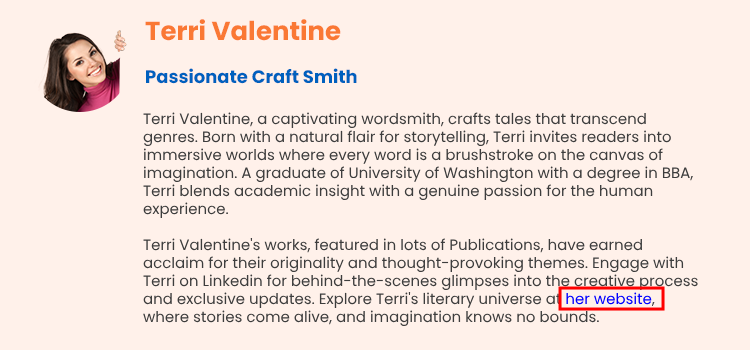
A less common scenario during guest blogging is when you include backlinks in your bio. The link you get from here is generally nofollowed since it’s not contextually placed. You can link to one of your top content there or even your homepage if you think that you can provide a great amount of information to the readers.
In this case, links are placed at the bottom of a page known as the footer. Footer links are usually less preferred because they are less noticed. As a result, they are often non-contextual and nofollowed.
A plus point is that footer links are generally found on every page of a website since the footer is always there. So, you can get a great many backlinks from a single deal. This type is also called a sitewide backlink.
However, it’s all about visibility and readers don’t find the bottom of a page particularly interesting, do they?
Also, we barely ever go past the first couple of important pages of a site anyways. So, the effect of footer links remains questioned.
A widget is a mini application designed to link back to you from another site. Of course, the placement has to make sense. Otherwise, it will be in direct violation of the Google guidelines regarding widget links.
For example, if you are a travel agency, you can add a widget about your holiday packages on one of the travel blogs online. However, if your widget leads to misleading information about your offers e.g. hidden charges, then Google may penalize you.
So, beware of the rules and be transparent about your business.
Code an HTML and give it to your prospect site. The site will incorporate the code in a relevant page of their site and every click will ensure traffic to your site.
A sidebar link is exactly what it sounds like. It’s just another sitewide link like footer link since sidebars are present throughout the website on every page. Links on sidebars are easily accessible which is something we couldn’t say for footer links.
However, the law of diminishing returns applies here as well (the number of clicks keeps decreasing in later pages). To know how Google sees sidebar links, watch this video here-
If your arms are sore from writing everyday and you want a break, we got you there as well.
You can offer an audio version of your prospect’s blog by sending them your recorded mp3 file embedded with the HTML and a backlink to your site. This way, they get a free audio version of their blog should they choose to use it and you get your backlink. Win-win!
If you’re into video making or editing and offer visual content, then go for video backlinks. It’s much easier since all you have to do is get a backlink to your video on YouTube. However, you have to be extremely careful about the content you’re making. Your video has to be classy, exceptional and engaging to avoid getting lost among so many similar content available today.
Underrated SEO techniques to say the least. In this day and time, PDFs and slideshows can come really handy to hook your audience.
All you need to do is create some quality SEO-friendly pieces. The content should be informative like a practical guide, and evergreen at the same time. Don’t just link to a PDF and sit back. Keep updating your content to sustain. Build an internal linking structure and maintain relevance throughout the text.
Host your PDF and slideshows inside the website. This allows Google and search engines to crawl and index your content. Don’t forget a call-to-action button for a download option as well.
24. Organic Link Building
This is hands down the best, the safest and the most ethical way of link building. The idea is to get backlinks by natural means; i.e., on-page and off-page SEO, quality linkable content, a rich backlink profile, and a genuine outreach program.
There’s no step-by-step methodology for it. This has to come from you through an all-around effort into your overall SEO campaign.
Google likes it when you build your links organically since that’s what makes webmasters stand out as authentic SEO practitioners.
The working recipe is the natural practices we just mentioned earlier.
Want a secret ingredient? User-intent. Just do what you feel benefits your users.
Natural link-building being a tedious process doesn’t appeal to a lot of up and coming marketers. They want their break fast and easy. So, paying for link-building campaigns starts sounding like a great idea.
Paid link building does not only boost your search engine rank satisfactorily, it does so with effect.
However, money is not the only thing that you compensate for in this approach. This method risks serious penalties too since Google’s spam algorithm doesn’t consider it natural.
Doesn’t mean all paid approaches are punishable by the way. You have to be honest and open about it, that’s all.
As we’ve discussed above, adding certain attributes lets Google differentiate between the spam links and links acquired for a purpose.
You can sneak away with paid link building techniques if you can make them seem natural to search engines but that’s a topic for another day.
Link exchange is a mutual arrangement between two or more website owners for trading backlinks with one another. Sounds like a cheaper and an innocent plan to build your backlink profile? Well, guess again. Google does penalize you if you overdo it too.
Related Article: How Many Backlinks Do I Need?
You already know Google isn’t exactly fond of paid link-building. If you partake in link schemes on top of that, imagine the horror!
Link farms and Private Blog Network (PBN) are both similar link schemes only departing in their structure. While link farm is solely built to provide inbound links to a target site, PBN is a more private network dedicated to exchanging links among a select group of websites.
Both give you low quality backlinks only to have Google crawl and index your site. Trust us, there’s no way you can come out a winner being a part of them. The poor quality links hurt your SEO and spamming like this only increases your chance of being penalized.
Many link building software and tools have emerged that manage a huge amount of backlinks from different web platforms like blogs, forums and stuff.
Relying on automation software to send you backlinks is a mistake because you don’t know how and where those links are coming from in bulk. It’s also dangerous since you’re actually manipulating your SERP ranking by following a black-hat SEO strategy. Google won’t be kind to you if it somehow detects your footprint.
If you’ve put up an inauthentic business profile, or been spamming forums and comments with your links indiscriminately, the inherent value of your links goes down.
Same thing happens if you’ve got quality links but keep posting them on totally unrelated sites or niches. You’re making it hard for Google to crawl here.
Press releases usually contain some special news bits about your company- for example, a new product launch or rebranding.
However, mind you- “Casual Dress Friday” is NOT a news.
So, if you haven’t got something really big cooking up, don’t bother going for a press release. Not only will you get nothing out of this, the link might get flagged as spam.
We know what you’re thinking. Yes, it was an exhausting list to even skim through.
But once you get the hang of how different types of backlinks work, it will prepare you better for a safe and sound link building strategy for your company.
You don’t need to worry about garnering in-depth knowledge about every type. Each needs a different approach to handle and if you’re sincerely involved in your company’s SEO, you’ll become good at predicting the right one for your business in no time.
Avoid any black-hat tactic and engage in the grey hat practices at least to save yourself the trouble from search engine spam algorithms.
Always remember that quality of backlinks matters more than their quantity. So, no matter which type you choose for your SEO campaign, you should focus on how to optimize them to your advantage.
Q. Are backlinks the only factor affecting my SEO rankings?
Ans. While backlinks are absolutely crucial for your SEO ranks, it’s not the only factor. Content quality, site structure, UX design- all of them play distinct roles to decide your ranking after all.
Q. Are internal links backlinks?
Ans. Internal links are not backlinks. They are links that interconnect different pages within a website and make it easy to navigate for users as well as Google.
Q. Are social media links considered backlinks for SEO?
Ans. While social media links are not exactly backlinks at all, they can still achieve similar effects by ensuring referral traffic and increased visibility.
Q. Do backlinks from .edu or .gov domains carry more weight?
Ans. Yes, educational and government sites are considered more authoritative in nature. However, getting contextual backlinks is more important.